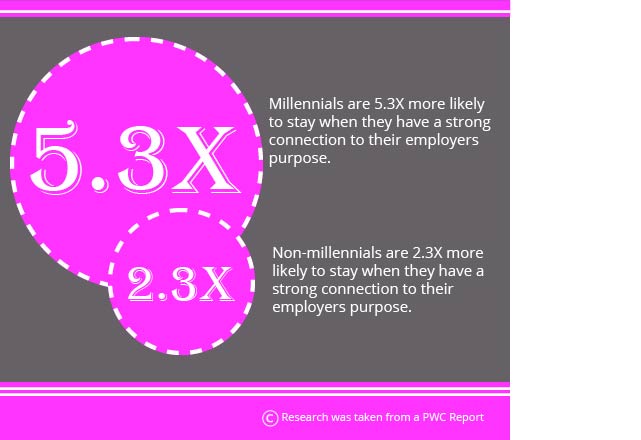We introduce multiple methods for increasing staff engagement in your contact centre, while also sharing a checklist to help you find opportunities to motivate employees.
The Three Keys to Engaging Employees
In their book “Primed to Perform“, authors Neel Doshi and Lindsay McGreogor examined how we can build high performing workplace cultures by better understanding human psychology.
In doing so, they put forward three principles for increasing staff engagement: purpose, potential and play.
- Purpose – Do you work because you value the impact that your work has? If the outcome of our work meets our personal values, we’ll be much more engaged in the process of meeting those outcomes.
- Potential – Is the work that you are doing a stepping stone for your career goals? If we sense that our work is enhancing our potential and is helping us to meet future aspirations, we will care a lot more about the work we are doing.
- Play – Are you motivated by the work you are doing alone? If we work because we enjoy it and have the opportunity to contribute, be creative and experiment, we will be much happier to undertake the tasks that we’re assigned.
Each of these factors has great relevance to contact centre management and, if we can build them into our culture, we can systematically improve staff engagement.
Below is a closer look at each of these three key principles, while each section has a mini checklist, so you can assess how well you are motivating advisors in each area.
For an overall checklist that covers each of these key areas, click here.
Staff Engagement Key Number 1 – Purpose
Purpose-driven branding is something that has become very big, not just in terms of attracting customers, but in terms of recruiting and engaging staff too.
In fact, if you do stand for a certain cause, younger cohorts of employees will find that particularly attractive, as evident in the PwC research that’s highlighted below.

The lesson here is that if we, in the contact centre, can articulate what our mission is, in a much more visible way, that is a great engagement tool.
To help you create a more transparent purpose and boost staff engagement, we have three key pieces of advice for motivating employees and, in particular, your younger advisors.
1. Teach the “Why” and the “How”
There is a simple principle in life that when people understand why they are doing something, they do it a lot better.
This seems straightforward, right?
Well then, why do we so often just tell our team members how to do something without articulating the purpose of it?
We tell advisors how to answer this query type, how they can improve their individual performance and how they can share their knowledge with the wider team. Yet we’re missing the “why?”
For true staff engagement, the team need to know why their contribution matters.
A simple way to bring this principle to life is, next time you’re explaining how to do something, think about how you can turn the conversation around and focus on the “why?”.
Show the advisor why they do something and why it matters, because that will appeal to their basic human desire for having a reason to do something. This will improve their engagement.
2. Show Staff the Impact That They Make on a Personal Level
Now advisors know the significance of their contribution to the business, we need to put processes in place so that they feel the impact they make on a personal level. We also want to ensure that they are continuously being motivated by that purpose.
Purpose gives the work that we do meaning. But we need to refill this purpose with regular recognition and evidence that the work individual advisors are doing is making a difference.
So, think about how advisors make an impact, what that impact is and whether advisors get any feedback, on a personal level, not necessarily just from a team perspective.
While we can do this to an extent through metrics like quality scores, we want to better celebrate great customer feedback, bring happy customers in the contact centre or maybe even create and share videos with thankful customers.
By creating your own ideas like these, you can show staff the real-world impact that they have.
From this, we can see that it is better to avoid relying solely on reward schemes to engage staff; we instead want the engagement to be intrinsic. If motivation is intrinsic, advisors will be helping customers for all of the right reasons.
3. Have a Stance Around Diversity and Inclusion
In the last few years, diversity and inclusion has been a key focus across many organizations, and younger staff members are generally much more expectant of clarity in this area.
With this in mind, Martin Hill-Wilson, Founder of Brainfood Consulting, suggests: “Create a statement of intent in this area and follow that up with some specifics that are outlined in a dedicated plan.”
Have this statement of intent, which can just be a simple sentence stating your commitment to building a diverse and inclusive culture, included on your careers page, to send a strong message to applicants early.
Then, lay out your plan – including how you celebrate events for underrepresented minorities, support related charities and create social media campaigns – in induction training. This will, over time, help to establish diversity and inclusion as a key part of your contact centre ethos.

Domestic & General’s contact centre in Brighton sponsors LGBT+ events and supports related causes throughout the year!
But what does all of this have to do with staff engagement?
It goes back the overriding principle of standing up for something and having a purpose. If young team members value your purpose, they will likely better value the work that they do for you.
Purpose often comes from good storytelling. For more on this as a topic, read our article: Storytelling: The Modern Way to Increase Staff Motivation
Checklist: How Well Are You Engaging Staff Through a Purpose?
From the three points just discussed, here are five key questions to ask yourself when considering how you use “purpose” as a tool for staff engagement:
- When coaching advisors, do you make a point of telling them why they need to do something, as well as how?
- Do you have any initiatives to bring staff together with customers off the phone?
- Do you share customer feedback with the advisor who handled their contact?
- Have you outlined a clear diversity and inclusion plan?
- Do you actively support any charities that support a more inclusive society?
Staff Engagement Key Number 2 – Potential
Not many new recruits walk into contact centres and consider it to be a long-term career option.
However, if we can support individuals in meeting their future aspirations and show them how the work that they are doing can help them to reach their future career goals, we can improve staff engagement.
In fact, this support can be invaluable, especially when we consider that research by Hays in 2017 found that 81% of employees are considering leaving their job.
So we need to present the work that team members are doing as work that increases their potential. Here are three ideas that will help you along the way.
1. Give People a Sense of Moving Forwards
The days on which people sense they are making progress are the days on which they are motivated and engaged, so we want to give employees the idea that they are making progress day after day.
One way to do this is by constantly providing advisors with little tips and tricks to help them do things differently. We need a structured approach to this – maybe changing our focus onto a different key part of the advisor role each month and tracking their improvement through a specific quality focus.
Just think about it like this: if we learn how to do something today that we didn’t know yesterday, we gain a sense of progress, moving forward and getting better.
How else can we apply this principle to the contact centre?
Ultimately, what we are working towards here is a sense of mastery. People want to beat their personal bests, not just at work, but in life too.
So the aim is to put people in positions where they feel that they are making progress.
What we want to do is think about how we can give people more quick, informal feedback – even if it’s just saying thank you more often.
2. Get Creative Around Autonomy
Advisor autonomy is often lauded to be the key to unlocking great performance and engagement. But in cultures based on adhering to strict processes and procedures, few contact centres really achieve this.
Instead of autonomy, what contact centres often achieve is a compliant workforce, who are able to do what you want them to do, in the way you want them to do it – and this often leads to achieving some success.
Yet this approach is not good in terms of a staff engagement, and contact centres that operate in this way will likely have high attrition rates.
No team will ever be truly engaged with their work while being micromanaged. People are much better engaged when they have a say in what they do.
If we want to achieve high staff engagement, we need to create an environment in which team members have a certain amount of control over what they do, as well as how and when they do it.
To do this, we can give employees more control over their schedule, a free afternoon to come up with contact centre improvement ideas – which they then pitch to the manager – and maybe even let them have more of a say in how their performance is assessed.
Only when advisors work in an environment like this, where people have more ability to direct their own lives, will they feel as though they are reaching their full potential.
3. Offer Mobile Microlearning Opportunities
For many contact centres, it’s difficult to create the time for formal learning and development – meaning that we cut off an entire avenue of engaging staff through potential.

Martin Hill-Wilson
But, to eke out that extra bit of time, we can provide microlearning on smartphones, which advisors can do before, during and after their shifts.
According to Martin: “This can be hugely engaging and it is one of those things that is very attractive to a young workforce, as you are offering them the opportunity to progress their own skills as part and parcel of their work with you.”
By making learning available on advisors’ smartphones, we reinforce learning in small doses, and that helps advisors to feel as though they are constantly making progress.
Also, having the choice on where to improve empowers the autonomous learner, while we can also use mobile apps to display training progress and personalize development.
So, creating an e-learning strategy through smartphones can be great, as we can use the devices to view and perhaps even adapt work schedules.
Checklist: How Well Are You Engaging Staff Through Potential?
From the three points above, here are five key questions to ask yourself when considering how you use “potential” as a tool for staff engagement:
- Do team leaders say thank you to advisors whenever they do something well?
- Do we make progression opportunities clear to staff members?
- Do we have mechanisms for listening to advisor ideas for how to improve the contact centre?
- Do advisors fully understand how their performance is assessed and do they have a say in it?
- Do we offer any mobile microlearning opportunities?
Staff Engagement Key Number 3 – Play
If we are enjoying our work, then we’ll be much more engaged in doing it.
However, no matter how many additional tasks we give advisors, the fundamental aspect of the role is going to be very repetitive.
Sure, we can give advisors good advice, such as “focus on the intrinsic rewards”, but if people aren’t happy while they work, that’s going to negatively impact staff engagement.
In fact, a Harvard Business Review study found that happy employees experience 31% higher productivity.
So we want to create a workplace culture that has that element of fun to it. Here are three key pieces of advice for achieving that within the contact centre.
1. Give Staff Control Over the Play
Play in the contact centre often involves organizing social events, playing motivational games and finding other ways of allowing advisors to exercise their hobbies in the workplace.
But whenever we devise a strategy around any of these ideas, we must remember that telling people how to have fun is not the way to go.
If we want to achieve high levels of staff engagement through play, employees should have a role in designing the play, so there is greater buy-in on the contact centre floor.
Again, we come back to this point about advisor autonomy. If the advisor has more say in what they do, they’ll have a better focus on making the fun activity a success.
But what we do need to remember here is that we are asking the team to design activities to increase staff engagement, not only advisor satisfaction.
While we ideally want to do both, the game should be related to the work that we are doing and focused around improving customer experience also.
2. Ask the Team to Create Engaging Learning Material
People are motivated by the thought of becoming an expert at something, so we want them to feel like they’re progressing and that they are on their way to becoming a “master” in what they do.
This was a point that we made earlier when discussing increasing staff engagement through potential, but if we are now developing “master advisors”, we can give them the opportunity to share their knowledge through play.
Using all of this knowledge that advisors are building, give them the chance to make posters, film videos or even create webinars, so we build up great learning content.
We can then spread these throughout the contact centre, to consistently engage staff with learning, and we can also use the content during induction training – so we build a knowledge library that appeals to all of the different ways that people learn.
By generating all of these different types of learning materials, we are also giving advisors the chance to realize the great progress that they have made in developing their knowledge. It also brings in the fun element of creativity and experimenting with different media forms.
3. Schedule to Meet Young Lifestyles
People will be less keen to join in with fun activities and work hard if they are missing out on something outside of the workplace, and this link between workforce management (WFM) and staff engagement is too often overlooked.
Play inside the workplace is no doubt worthwhile, but fun outside of the workplace is much more important, and having the right work–life balance is key for young advisors.
Many millennials don’t like the idea of working a traditional five-day, 37.5-hour week. They want a job that facilitates their lifestyle and “play” outside of the workplace.
So, first of all, we want to design our shift patterns to suit certain lifestyles. But a much simpler tip is give everyone the chance to set their own personal rule within their weekly schedule, as John Casey, a Resource Planning Expert at CCplanning, describes in the video below:
This is a great example of how we can use modern technology to engage young advisors, and by giving advisors this choice within the schedules, we increase their autonomy and consequently their engagement.
Find out more about modern WFM technology in our article: Beginner’s Guide to Workforce Management Software
Checklist: How Well Are You Engaging Staff Through Play?
From the three points outlined in this section in the article, here are five key questions to ask yourself when considering how you use “play” as a tool for staff engagement:
- Do we give staff the freedom to plan social events and motivational games?
- Do team leaders know their advisors’ hobbies outside of work?
- Do we give expert advisors the chance to share their expertise with the wider team?
- Do we make learning materials available in a variety of different formats?
- Have staff got any flexibility in their shift patterns, beyond shift swaps?
In Summary
To increase staff engagement, one approach is to focus on three distinct areas of contact centre management: purpose, potential and play.
If we can build these into our culture, we will systematically increase staff engagement, without having to constantly think of one-off initiatives to build motivation.
Also, to test where you are now, we have built all the information that’s included in this article into a simple checklist, which may highlight the key areas that you need to focus on in terms of building staff engagement.
We hope you score well!
For more on the topic of staff engagement, read our articles:
- Remote Staff Engagement: 9 Strategies to Make Your Team Smile
- 7 Simple Strategies to Increase Staff Motivation in the Contact Centre
- How to Calculate an Employee Engagement Score
Author: Robyn Coppell
Published On: 5th Feb 2020 - Last modified: 5th Feb 2025
Read more about - Call Centre Management, Editor's Picks, Employee Engagement, Fun, Martin Hill-Wilson, Motivation, Printable, Staff Recognition




































